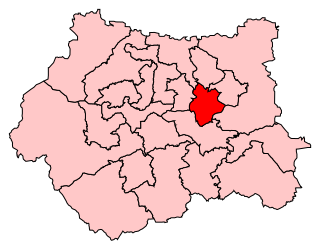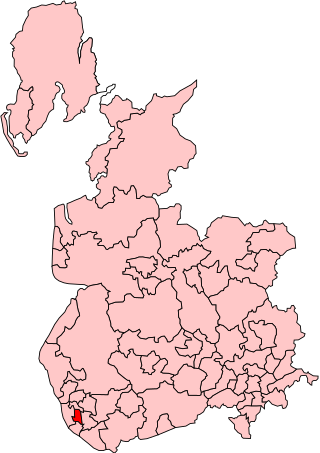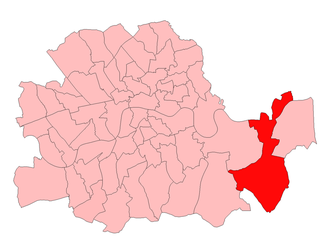
Sheffield Attercliffe was a parliamentary constituency in the City of Sheffield. It was created at the 1885 general election and abolished at the 2010 general election, when it was replaced by a new Sheffield South East constituency.

Leeds Central was a constituency represented in the House of Commons of the UK Parliament. The constituency first existed from 1885 until it was abolished in 1955. It was recreated in 1983.

Bradford North was a borough constituency represented in the House of Commons of the Parliament of the United Kingdom. Until it was abolished for the 2010 general election, it elected one Member of Parliament (MP) by the first past the post system of election.

Leeds West was a borough constituency covering the western part of the city of Leeds, West Yorkshire which is represented in the House of Commons of the Parliament of the United Kingdom. It elected one Member of Parliament (MP) by the first-past-the-post system of election. With the exception of the Parliament of 1983–87, the seat was held by Labour since 1945.

Leeds East is a constituency represented in the House of Commons of the UK Parliament since 2015 by Richard Burgon of the Labour Party until his suspension and whip withdrawn on 23 July 2024, as a result of voting to scrap the two child benefit cap. He now sits as an Independent MP until the whip is re-established.

Liverpool Edge Hill was a borough constituency within the city and metropolitan borough of Liverpool, in the English county of Merseyside, centred on Edge Hill. It returned one Member of Parliament (MP) to the House of Commons of the Parliament of the United Kingdom, elected by the first-past-the-post voting system.
East Grinstead was a parliamentary constituency in the Kingdom of England, the Kingdom of Great Britain, and the United Kingdom. It first existed as a Parliamentary borough from 1307, returning two Members of Parliament to the House of Commons elected by the bloc vote system. The borough was disfranchised under the Reform Act 1832, but the name was revived at the 1885 election when the Redistribution of Seats Act created a new single-member county division of the same name.
Birmingham Aston was a constituency of the House of Commons of the Parliament of the United Kingdom. From 1918 to 1974 it elected one Member of Parliament (MP) by the first-past-the-post system of election.

Woolwich East was a parliamentary constituency represented in the House of Commons of the Parliament of the United Kingdom from 1918 until 1983. Its seat was Woolwich, now in the Royal Borough of Greenwich in south-east London.

Woolwich West was a borough constituency represented in the House of Commons of the Parliament of the United Kingdom from 1918 until 1983. It centred on Eltham, now in the Royal Borough of Greenwich in south-east London.
Manchester Ardwick was a parliamentary constituency in the city of Manchester which returned one Member of Parliament (MP) to the House of Commons of the Parliament of the United Kingdom. Elections were held by the first past the post voting system.

Fulham West was a borough constituency based in the London district of Fulham. It was represented in the House of Commons of the Parliament of the United Kingdom from 1918 to 1955.

Salford West was a parliamentary constituency in the City of Salford in Greater Manchester from 1885 until 1983. It returned one Member of Parliament (MP) to the House of Commons of the Parliament of the United Kingdom.

Leeds South is a parliamentary constituency in the city of Leeds, West Yorkshire, which returns one Member of Parliament (MP) to the House of Commons of the Parliament of the United Kingdom. The constituency existed from 1885 to 1983 and was recreated in 2024 following the 2023 Periodic Review of Westminster constituencies.

Tonbridge is a parliamentary constituency in Kent, centred on the town of Tonbridge. It returns one Member of Parliament (MP) to the House of Commons of the Parliament of the United Kingdom.
Birmingham Handsworth was a parliamentary constituency centred on the Handsworth district of Birmingham. It returned one Member of Parliament (MP) to the House of Commons of the Parliament of the United Kingdom. It was abolished in 1983.
Leeds North was a borough constituency in the city of Leeds, West Yorkshire, which returned one Member of Parliament (MP) to the House of Commons of the Parliament of the United Kingdom, elected by the first past the post voting system.
Richmond (1918–1983) was a parliamentary constituency centred on the town of Richmond. The seat mirrored for its first 47 years a small northern projection of Surrey. For the final 18 years its area, in local government, fell into the new county of Greater London.

East Ham South was a parliamentary constituency centred on the East Ham district of London, which was in Essex until 1965. It returned one Member of Parliament (MP) to the House of Commons of the Parliament of the United Kingdom, elected by the first past the post voting system.

East Ham North was a parliamentary constituency centred on the East Ham district of London, which was in Essex until 1965. It returned one Member of Parliament (MP) to the House of Commons of the Parliament of the United Kingdom, elected by the first past the post voting system.















